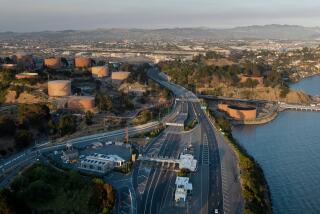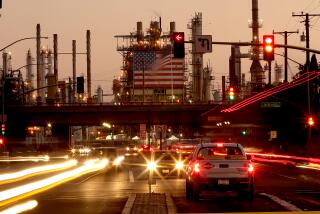Chevron Profit Plummets After Special Charges
- Share via
Lambasting what it called “an irrational public policy process,” Chevron on Wednesday announced that it reduced by $445 million the value of its investment in an offshore oil field near Santa Barbara and took other special charges, causing 1989 earnings to plummet.
The San Francisco-based oil giant reported 1989 earnings of $251 million, compared to nearly $1.8 billion in 1988. The 1989 results reflected $1.207 billion in special charges, while 1988 results were boosted by $77 million from special items.
Revenue rose to $32.8 billion from $28.9 billion the year before primarily because of higher prices for Chevron’s refined products and crude oil, and higher sales of crude oil and natural gas, the company said. Total operating earnings, excluding the special charges, fell 14% to $1.46 billion, mainly because of higher oil costs.
For the fourth quarter, Chevron posted an $883-million loss, which included $1.203 billion in special charges. In 1988, fourth-quarter earnings of $175 million included special charges of $266 million.
At the heart of Chevron’s earnings plunge is a dispute with the California Coastal Commission over how to transport oil from the huge Point Arguello oil and gas reserve off the Santa Barbara coast. A consortium of oil companies led by Chevron has been unable to get permission from the Coastal Commission to transport oil by tanker from a new terminal near Gaviota to Chevron’s El Segundo refinery.
Costs caused by delays in the project, which has been ready for production for more than two years, and other factors swelled the project’s book value beyond its actual worth, the company said.
“We’re extremely disappointed by our experience at Point Arguello, which we have been developing since the early 1980s, when higher crude oil prices and significantly fewer regulatory obstacles were expected,” said Chevron Chairman Kenneth T. Derr. “After enduring a series of adverse rulings from what appears to be an irrational public policy process, I think it is prudent to assign a more realistic value to this project.”
Opponents of the project have said Chevron has not dealt with the question of the hazards of shipping oil through the Santa Barbara Channel, an area that was devastated by a 1969 oil spill.
Chevron’s writedown assumes that production will begin by late this year, a company spokesman said. Texaco and Phillips Petroleum have also written down their investment in the Point Arguello field.
Analysts said the decline in Chevron’s operating earnings was a slight disappointment for a company that has been restructuring to improve its lackluster performance and the writedowns were higher than expected.
“Chevron wanted to be more conservative” by taking large writedowns, which may reflect some concern about the 8.8% stake that Pennzoil recently bought, said Craig Schwerdt, an oil industry analyst with Seidler Amdec Securities in Los Angeles. Taking writedowns now would improve financial performance later, should Pennzoil threaten a takeover, he added.
Chevron’s stock closed at $65.375 a share on the New York Stock Exchange, down 12.5 cents.
Elsewhere in the oil industry, Shell Oil earned $1.4 billion, up 13% from 1988, on revenue of $21.9 billion, up 2%. Fourth-quarter earnings jumped 25% to $264 million, while revenue was unchanged at $5.5 billion.
Sun Co. recorded 1989 net income of $98 million, which included $177 million in after-tax charges, compared to $7 million the year before, which included $314 million in after-tax charges. Revenue totaled $11.4 billion, up from $10 billion in 1988.
For the fourth quarter, Sun reported a net loss of $173 million. In the year-ago quarter, Sun had net income of $76 million. Revenue rose to $3.1 billion from $2.7 billion.
OIL SPILL COSTS
Exxon Corp. raised its estimate of the 1989 costs of cleaning up the massive Alaskan oil spill to $2 billion. D2
More to Read
Inside the business of entertainment
The Wide Shot brings you news, analysis and insights on everything from streaming wars to production — and what it all means for the future.
You may occasionally receive promotional content from the Los Angeles Times.










